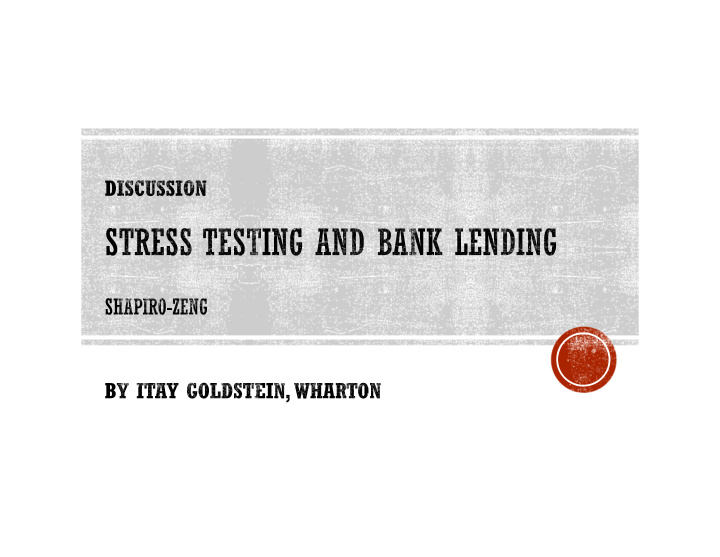



Regulator conducts stress tests for a bank over two periods Prior to the test, in each period, bank can make risky or safe loans Risky loans turn out to be good or bad , which is revealed in the course of the stress test Following the stress test, regulator can fail the bank , requiring costly recapitalization, or pass it Regulator has an objective to either encourage or discourage risky loans , which is not internalized by the bank Regulator can be one of three types: Strategic (acts to maximize objective function), lenient (always passes), or strict (always fails) 2
In the first period, strategic regulator may deviate from static optimal behavior ( informative equilibrium ) to affect bank’s choice in second period E.g., regulator who wants to encourage risky lending will pass a bank with bad loans with some probability: Soft equilibrium This is a signaling mechanism: passing the bank increases the perceived probability of being lenient and decreases the perceived probability of being strict; increasing incentive for the bank to engage in risky lending Similarly, a tough equilibrium may exist for other parameters Multiple equilibria may exist: Playing a tough strategy (when trying to discourage risky loans) implies that, if the bank passes, the regulator is very likely to be lenient This encourages the bank to make risky loans, and so the regulator is even more justified in his tough strategy This reinforcing mechanism means that informative and tough equilibria can co- exist 3
Stress test results can deviate from informative ones for external regulatory considerations E.g., in Europe, soft tests were designed to encourage lending when credit markets froze Efficiency loss in case there are multiple equilibria and tough or soft equilibria are played instead of the informative one Capital availability makes informative equilibrium more likely If recapitalization is not feasible, then deviating from static optimal behavior is less costly 4
Do signaling and reputation considerations play an important role in regulators’ behavior around stress tests? PROBABLY Do stress tests have an important role in affecting bank lending? POSSIBLY Does the model feature plausible ingredients? SOMETIMES Does the paper generate implications of first-order importance? NOT ALWAYS Overall , I like the paper’s general message, and I think there is a lot of potential, but I would recommend some improvements… 5
Reputation building mechanism: Why would a regulator be lenient or strict ? Why is this regulator type independent of the desirability of risky lending? If stress tests are happening annually , can we think about the regulator trying to signal type for next year? Wouldn’t type change by then? Given that stress tests are happening across different banks, shouldn’t updating occur based on multiple banks ? Recapitalization mechanism: Is it reasonable that equity holders are better off when recapitalization fails than when it succeeds? Overall: The model has many ingredients and restricting assumptions ; it seems that key intuition can come out of a simpler environment 6
While the reputation channel is theoretically interesting, it is not clear what it helps explaining about stress tests that could not be explained otherwise The result that regulators who want to encourage risky lending would be softer in equilibrium can be obtained in a simpler static model without reputation motives The result on social cost of bank lending can also come out of a static model The result on capital availability seems to depend on the way recapitalization is modelled, as explained above Overall , takeaways should clearly differentiate from those obtained in static reputation-free models 7
Equilibrium multiplicity is quite generic in models of signaling and reputation; why emphasize them here? Questions of efficiency are interesting regardless of whether we have multiple equilibria or not; ask a more general question: how does reputation concern affect efficiency? Other implications drawn from multiplicity regarding difficulty in coordination are not well motivated and lack clear foundations 8
As authors note, most of the theoretical literature dealt with disclosure of stress test results, while here it is about regulatory action being tough or soft One issue to think about is whether this model is unique to stress tests or more generally about bank regulation Another point to consider is that regulatory policy being tough or soft and disclosure policy are inherently linked See point made in Goldstein-Leitner (forthcoming Stress-Tests- Handbook chapter): a policy of full disclosure can be equivalent to a policy of running very weak tests 9
Recommend
More recommend